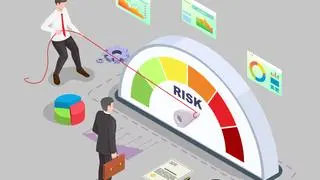The record-beating ₹14,700-crore launch of SBI MF’s Balanced Advantage Fund in August 2021 brought this fund category under the spotlight once again. The surging Sensex since the lows of March 2020 had added to their appeal. With the recent slide in the market and much speculation on its future trajectory, balanced advantage funds may again find favour with investors.
BAFs juggle equity and debt in line with changing market conditions and have become the go-to-choice for mutual fund investors concerned about steep equity valuations. Today, BAFs manage assets worth ₹1.6 lakh crore, nearly twice as much of that a year ago.
What are they?
Simply put, balanced advantage funds (BAF) or dynamic asset allocation funds (DAAF) are hybrid funds — they invest in a mix of equity and debt instruments. However, unlike other hybrid funds that vary their equity and debt allocation within a SEBI-defined range, BAFs manage this dynamically (no pre-set limits) in line with changing market dynamics. Such funds modify their equity exposure depending on how attractive the stock market looks based on factors such as market valuations and trend (momentum). BAFs pare their equity exposure when markets are at a high and raise it when they are at a low.
BAFs typically use a model based on a set of metrics to arrive at their net equity (total equity minus derivatives exposure) allocation. To enjoy favourable equity taxation, BAFs ensure that their total equity exposure is at least 65 per cent. The hedged equity exposure as well as that held in debt instruments help temper the volatility in fund returns. When markets are at a high, a fund may hedge a relatively large part of its equity exposure as also up its debt holdings, thereby limiting the impact of a market fall. Conversely, a fund will invest aggressively in equity when markets are at a low.
The selling point of BAFs is that they can provide you a hassle-free asset allocation by automatically modifying your equity and debt allocation based on market conditions. This translates into reduced short-term volatility in returns too, compared to, say, a pure equity fund. By automating the change in equity-debt allocations, they can save investors from panic-selling during a market fall or investing aggressively when equity markets are at a high. BAFs are also more tax-efficient – equity-debt reallocations at the fund level have no tax implications compared to when you undertake this exercise on your own. Such rebalancing at an individual’s level — buying and selling your equity and debt investments — attracts capital gains tax.
While the above description broadly fits every BAF, the similarities end there.
Individual BAFs can be very different from each other. The BAF category came into existence in 2018 following SEBI’s recategorisation exercise. While there were funds (such as those from ICICI Pru, Edelweiss , DSP and ABSL MF) that followed a similar equity-debt investing strategy even earlier, for those that didn’t, their previous performance may not be strictly comparable with that post their conversion. For instance, Nippon India’s NRI Equity Fund, an equity fund investing in the BSE 200 companies, was recategorised as a BAF from May 2018. HDFC BAF was formed by the merger of the AMC’s Prudence Fund with its Growth Fund in June 2018 (the latter was converted to a BAF before the merger).
Different folks, different strokes
The SEBI mandate is simple — BAFs must invest in equity and debt and manage this mix dynamically. In practice, since different mutual fund AMCs follow varying models to arrive at their net equity allocation, the result is equally varied. Even where AMCs run models based on similar principles — valuation, market trend (or momentum) or a combination of the two — the results can be dissimilar.

On the one hand are BAFs driven purely by valuation-based models, for instance, from ICICI Prudential MF that uses price-to-book value and Aditya Birla Sunlife AMC that relies on price-to-earnings ratio. The BAF from Edelweiss MF, by contrast, follows a trend-based model that combines quantitative metrics such as daily moving averages (average of daily index values over specific periods) and downside deviation (extent of fall in index value in periods of market fall) for the Nifty 50 to gauge the market trend. So, if the market is trending up strongly (without many sharp ups and downs in the interim), the fund will start adding to its equity exposure.
Others, such as the Nippon India BAF, Kotak BAF and DSP DAAF, have models that combine both these factors. HDFC MF’s BAF is different from all — it keeps its entire equity allocation unhedged (no derivative exposure). It varies its asset allocation based on factors such as valuation, interest rates and the outlook for these assets.
A BAF run on a valuation-based model will up its equity exposure as markets fall and be heavily invested in equity at the market bottom. Compared to this, a trend-based model may not have the highest equity allocation at the lowest point but may gradually up its exposure as the market starts recovering from a low as pointed by various momentum indicators.
Hence, trend-based BAFs can provide better downside protection in periods when markets continue to fall. But it can also somewhat limit their upside compared to valuation-based models (that kept on adding more equity as the markets continued to fall), once the market recovery begins. Models that combine the two approaches will be somewhere in between. The outcome may also be influenced by the choice of the valuation metric.
Mixed record on managing downside
BAFs are meant to shield investors from equity market volatility by limiting the downside during market falls. The presence of hedged equity exposure and debt instruments in the portfolio enables this. However, BAFs have had a varied record on providing downside protection. Many BAFs also play it ultra safe on the credit risk front by investing only in sovereign and AAA-rated debt papers. A few, such as ICICI Pru MF’s and HDFC MF’s BAFs, however, invest a small portion in AA/ AA+ / AA- debt papers too, that are rated a notch lower.
Besides, within equity too, most BAFs allocate a good chunk to large-caps (47-61 per cent of total portfolio). Exposure to small and mid-cap stocks is small. Still, not all BAFs have delivered equally well on downside protection.
One way to gauge how a fund has fared is through its downside capture ratio (DCR). A value below 100 per cent indicates that the fund has fallen less than its benchmark index (or the fund has captured less of the downside) in periods when the markets fell. Lower the ratio, the better it is.
It comes as no surprise that HDFC BAF, which has significantly higher unhedged equity exposure in its category, has the highest DCR. While the higher allocation has helped the fund deliver the highest returns in the category, its performance has also been accompanied by grater interim volatility. Others, such as ICICI BAF, one of the top performers and Edelweiss BAF, have shown better downside protection by way of lower DCR. Another way to assess a fund’s record on downside protection is to see how sharply the fund NAV fell compared to the broader market during past periods of steep decline.

As one can see, the downside protection record has been very varied.
When to go for BAFs
That said, a top-performing BAF can serve you well and should have a role in your portfolio. If you have a 3-5-year investment horizon and want to limit return volatility but also not be tied down by low debt returns, a BAF can come in handy.
Among the few in the category to have managed its asset allocation dynamically from the start is the ICICI Pru BAF. Unlike most other valuation-based BAFs that use the P/E multiple, the ICICI Pru BAF uses the P/B ratio. In equity, the fund is focused on large and mid-cap stocks with a net equity allocation range of 30-80 per cent. In debt, it invests largely in shorter tenure papers, maturing in less than a year or 1-3 years, which caps interest rate risk (bond prices fall when rates rise). But it doesn’t shy away from investing in below AAA-rated papers, bringing in some risk.
Going by the last seven years’ data, the fund has been among the top performers in the category based on returns and downside protection. During this period, the scheme has outperformed the Nifty 50 TRI far more frequently than most other schemes in the category. Its 3-year and 5-year returns have exceeded those of the Nifty 50 TRI, 44 per cent and 52 per cent of the time, respectively. With a DCR of 43 per cent, it has also provided good downside protection relative to the Nifty 50 TRI.
When not to go for BAFs
If you are investing for the long run, say, for a goal beyond five years, a top performing equity fund (for instance, a flexicap fund) can fetch you better returns than a BAF. While BAFs may limit the downside in bear markets, they will also capture less of the upside in bull market years. One must, however, be prepared to experience sharper volatility in short-term returns with an equity fund.
Take the two top performing flexicap funds, Parag Parikh Flexi Cap and Kotak Flexicap and consider their returns over different periods from May 2013 till date .

While a BAF may provide better downside protection — lower downside capture ratio and fewer instances of negative returns over 1-year periods — this may come with lower long-term returns. Parag Parikh Flexi Cap ‘s value style of investing, and exposure to global stocks (up to 35 per cent), which provides risk diversification, help keep its downside risk lower than its category peers.








Comments
Comments have to be in English, and in full sentences. They cannot be abusive or personal. Please abide by our community guidelines for posting your comments.
We have migrated to a new commenting platform. If you are already a registered user of TheHindu Businessline and logged in, you may continue to engage with our articles. If you do not have an account please register and login to post comments. Users can access their older comments by logging into their accounts on Vuukle.